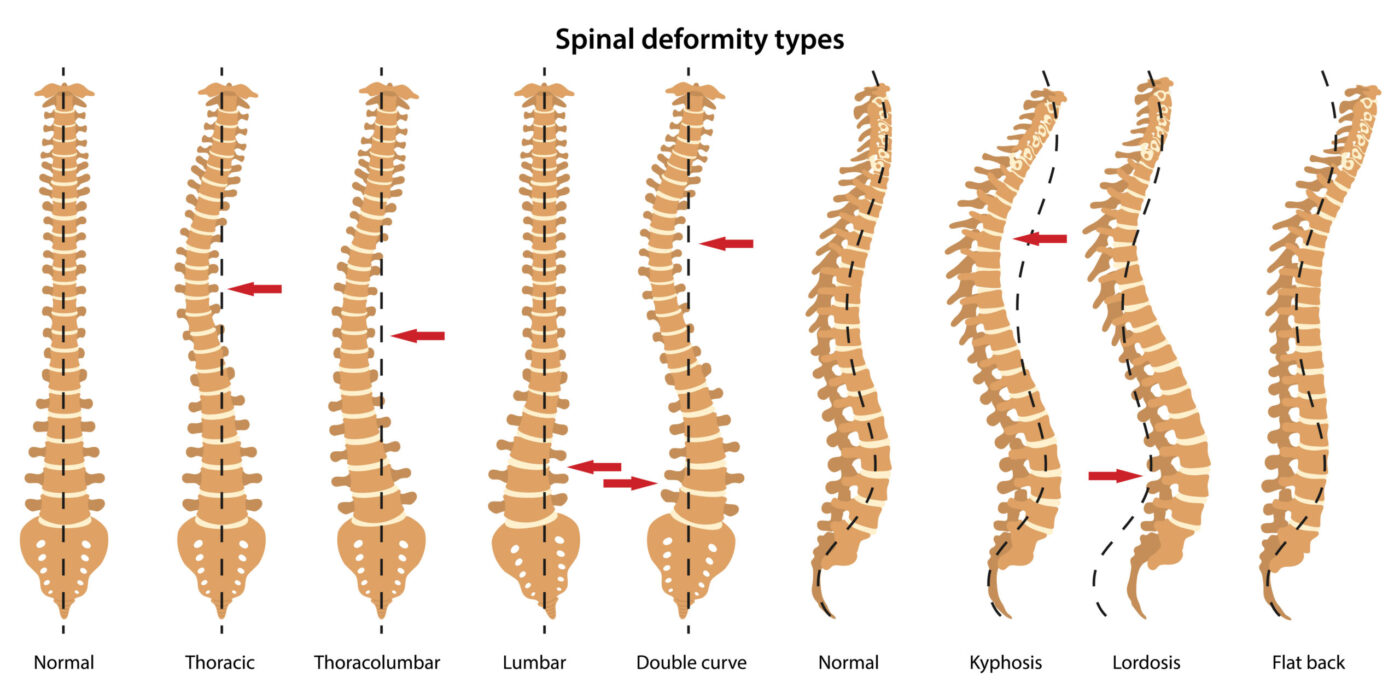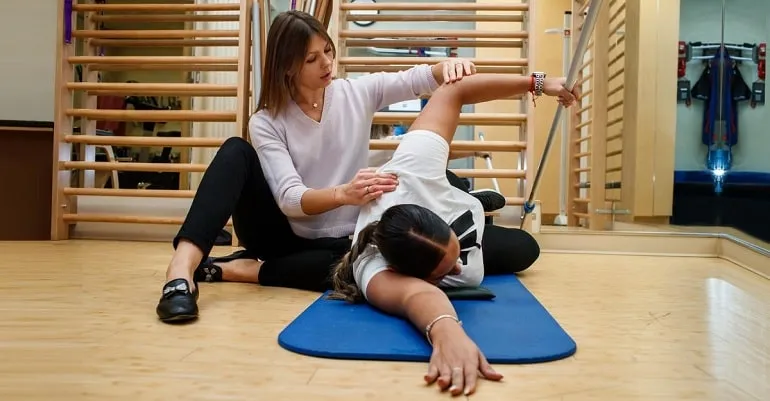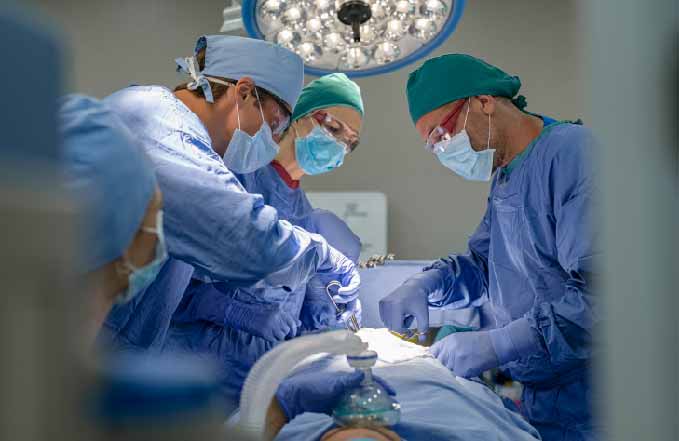Recuperação após uma cirurgia de escoliose: Scoliosis surgery is a major procedure that aims to correct the curvature of the spine. While the surgery itself is crucial in treating scoliosis, the recovery period is equally important for achieving optimal results. Understanding what to expect during the healing process and how to enhance recovery can greatly contribute to a successful outcome.

Preparing for surgery: what to expect
Before undergoing scoliosis surgery, it is essential to be well-prepared both physically and mentally. Your surgeon will provide you with detailed instructions on how to prepare for the procedure. This may include fasting for a certain period of time before surgery, stopping certain medications, and undergoing pre-operative tests.
In addition to physical preparation, it is important to mentally prepare yourself for the surgery. It is normal to feel anxious or nervous, but having a positive mindset and trust in your medical team can help alleviate these feelings. Talking to your surgeon or a mental health professional can also provide valuable support during this time.

Immediate post-surgery care and monitoring
After scoliosis surgery, you will be closely monitored in the recovery room before being transferred to a hospital room. During this time, you may experience pain, discomfort, and fatigue. The medical team will provide pain medication to manage your discomfort and monitor your vital signs regularly.
You may also have drains in place to remove excess fluid from the surgical site. These drains will be removed once the drainage decreases to an acceptable level. It is important to follow your surgeon’s instructions regarding wound care and incision site management to prevent infection and promote healing.
Managing pain and discomfort after scoliosis surgery
Pain management is a crucial aspect of scoliosis surgery recovery. Your surgeon will prescribe pain medication to help alleviate discomfort during the initial stages of recovery. It is important to take the medication as directed and communicate any concerns or changes in pain levels to your medical team.
In addition to medication, there are other strategies that can help manage pain and discomfort. These include using ice packs or heat therapy, practicing relaxation techniques such as deep breathing or meditation, and maintaining proper posture and body mechanics.
Physical therapy and rehabilitation exercises
Physical therapy plays a vital role in the recovery process after scoliosis surgery. Your surgeon will recommend a physical therapy program tailored to your specific needs. The goal of physical therapy is to improve strength, flexibility, and overall function of the spine.
Initially, physical therapy may focus on gentle range of motion exercises and breathing techniques. As you progress, exercises will become more challenging and may include core strengthening, stretching, and balance exercises. It is important to follow your physical therapist’s instructions and attend all scheduled sessions to maximize your recovery.

Dietary considerations for optimal healing
Proper nutrition is essential for optimal healing after scoliosis surgery. A well-balanced diet rich in protein, vitamins, and minerals can help promote tissue repair and reduce the risk of complications. It is important to consume a variety of fruits, vegetables, lean proteins, whole grains, and healthy fats.
In some cases, your surgeon may recommend nutritional supplements to ensure you are meeting your body’s needs during the recovery period. It is important to discuss any dietary concerns or restrictions with your medical team to ensure you are receiving adequate nutrition.
Wound care and incision site management
Proper wound care is crucial for preventing infection and promoting healing after scoliosis surgery. Your surgeon will provide specific instructions on how to care for your incision site. This may include keeping the area clean and dry, changing dressings regularly, and avoiding activities that may put strain on the incision.
It is important to monitor the incision site for any signs of infection, such as redness, swelling, or drainage. If you notice any concerning symptoms, it is important to contact your surgeon immediately. Following proper wound care guidelines can help minimize the risk of complications and promote a smooth recovery.
Potential complications and how to address them
While scoliosis surgery is generally safe, there are potential complications that can arise during the recovery period. These may include infection, blood clots, nerve damage, or hardware failure. It is important to be aware of the signs and symptoms of these complications and seek medical attention if necessary.
Your surgeon will provide you with information on potential complications and how to address them. It is important to follow up with your surgeon regularly and report any concerning symptoms. Early detection and intervention can greatly improve outcomes and prevent further complications.
Returning to daily activities and resuming normal life
Returning to daily activities and resuming a normal life after scoliosis surgery is a gradual process. Your surgeon and physical therapist will guide you through this transition, gradually increasing your activity level and providing recommendations on what activities to avoid.
It is important to listen to your body and not push yourself too hard too soon. Gradually increasing your activity level and following your medical team’s guidance can help prevent setbacks and promote a smooth recovery. It is also important to have a support system in place to assist with daily tasks during the initial stages of recovery.
Emotional and psychological support during recovery
Recovering from scoliosis surgery can be emotionally challenging. It is normal to experience a range of emotions, including frustration, sadness, or anxiety. Having a strong support system in place can greatly contribute to your emotional well-being during this time.
Talking to friends, family, or a mental health professional can provide valuable support and help you navigate the emotional aspects of recovery. Joining support groups or connecting with others who have undergone scoliosis surgery can also provide a sense of community and understanding.
Long-term follow-up and monitoring after scoliosis surgery
Long-term follow-up and monitoring are essential after scoliosis surgery. Your surgeon will schedule regular appointments to assess your progress, monitor the healing process, and address any concerns or complications that may arise.
During these follow-up visits, your surgeon may order X-rays or other imaging tests to evaluate the alignment of your spine and the integrity of the hardware used during surgery. It is important to attend all scheduled appointments and communicate any changes or concerns to your medical team.
Tips for enhancing recovery and promoting overall well-being
There are several tips that can enhance recovery and promote overall well-being after scoliosis surgery. These include:
- Follow your surgeon’s instructions: It is important to follow all post-operative instructions provided by your surgeon, including medication schedules, wound care guidelines, and activity restrictions.
- Stay active: Engaging in regular physical activity, as recommended by your medical team, can help improve strength, flexibility, and overall well-being.
- Practice good posture: Maintaining proper posture can help alleviate strain on the spine and promote healing. Avoid slouching or sitting for prolonged periods of time.
- Get enough rest: Adequate rest is crucial for the healing process. Make sure to prioritize sleep and listen to your body’s needs.
- Stay hydrated: Drinking enough water can help promote healing and prevent complications such as constipation.
- Seek emotional support: Reach out to friends, family, or support groups to help navigate the emotional aspects of recovery.
- Stay positive: Maintaining a positive mindset can greatly contribute to your overall well-being and recovery.
In conclusion, recovery after scoliosis surgery is a complex process that requires physical, emotional, and psychological support. By understanding what to expect during the healing process and implementing strategies to enhance recovery, you can achieve optimal results and resume a normal life. It is important to follow your medical team’s guidance, attend all scheduled appointments, and communicate any concerns or changes in symptoms. With proper care and support, you can successfully navigate the recovery period and achieve a positive outcome.
Referências
- Weinstein SL, Dolan LA, Cheng JC, et al. "Adolescent idiopathic scoliosis" (Escoliose idiopática do adolescente). Lancet. 2008;371(9623):1527-1537. doi: 10.1016/S0140-6736(08)60658-3.
- Negrini S, Donzelli S, Aulisa AG, et al. “2016 SOSORT guidelines: Orthopaedic and rehabilitation treatment of idiopathic scoliosis during growth.” Escoliose e doenças da coluna vertebral. 2018;13:3. doi: 10.1186/s13013-018-0175-8.
- Trobisch P, Suess O, Schwab F. "Escoliose idiopática". Dtsch Arztebl Int. 2010;107(49):875-883. doi: 10.3238/arztebl.2010.0875.
- Hresko MT. "Prática clínica. Escoliose idiopática em adolescentes". N Engl J Med. 2013;368(9):834-841. doi: 10.1056/NEJMcp1209063.
- Bettany-Saltikov J, Weiss HR, Chockalingam N, et al. "Intervenções cirúrgicas versus não cirúrgicas em pessoas com escoliose idiopática do adolescente". Base de dados Cochrane Syst Rev. 2015;2015(4). doi: 10.1002/14651858.CD010663.pub2.
- Lonstein JE, Carlson JM. "A previsão da progressão da curva na escoliose idiopática não tratada durante o crescimento". J Bone Joint Surg Am. 1984;66(7):1061-1071. doi: 10.2106/00004623-198466070-00008.
- Haher TR, Lerman JD, LaSalle D, et al. “Postoperative care of the patient with scoliosis.” Clínicas Ortopédicas da América do Norte. 1999;30(3):419-431. doi: 10.1016/S0030-5898(05)70114-2.
- Labelle H, Reddy AS, Skalli W, et al. “Long-term outcomes of surgical treatment for idiopathic scoliosis: Results of a multicenter study.” Coluna vertebral. 2009;34(14):1505-1513. doi: 10.1097/BRS.0b013e3181a559a0.
- Scoliosis Research Society. “Scoliosis Treatment Guidelines.” Sociedade de Investigação da Escoliose. Disponível em: https://www.srs.org/professionals/professional-research/scoliosis-guidelines. Accessed August 2024.
- Bess S, Asher M, Ghiselli G, et al. “Current concepts in the surgical management of scoliosis.” Jornal da Academia Americana de Cirurgiões Ortopédicos. 2009;17(7):418-429. doi: 10.5435/00124635-200907000-00002.

